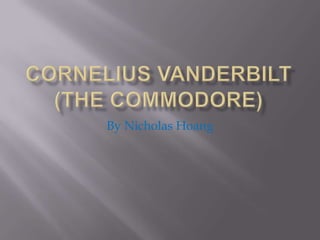
Cornelius Vanderbilt (the commodore)
- 2. Cornelius Vanderbilt was born in Staten, New York on January 4,1877
- 3. Cornelius Vanderbilt was born in Staten, New York on May 27,1794 to a very poor family At a young age he bought his first boat periauger and started shipping and was given the nickname(Commodore).
- 4. He shipped goods, products, and soon had many boats. When the Transcontinental Railroad was made he invested in railroads thinking it was the future and soon made a fortune from his investment. He acquired the New York and Harlem Railroad in 1862-1863, the Hudson River Railroad in 1864 and the New York Central Railroad in 1867. In 1869 they were merged into New York Central and Hudson River Railroad.
- 5. The railroad he owned was the only railroad into United States biggest trade center. And they wanted to go on his railroad for free. So Vanderbilt said, ‘‘Lets watch them bleed ’’. He didn’t let anyone use his road till they paid him and he became rich with that. He was rivals with Tom Scott(Andrew Carnegie’s mentor who also wanted to be King of Railroads
- 6. At this time he had at least 50% of all railroads but he wanted it all To become very powerful he needed the Erie Railroad and he bought all of it at the stock market Before he had gotten the Erie Canal, Gould and Fisk sold water-down stocks which are worth nothing and he lost over 1.1 billion’s worth in today’s money
- 7. Later on in life he achieved more accomplishments And was defeated by John D. Rockefeller(King Of Oil) He died on January 4,1877
- 8. One of his sons the one who had many features like his dad Cornelius Vanderbilt had died in a war His other son William had few features like him, was bad at business, and inherited Cornelius Vanderbilt’s money the most
- 9. As simple as this Cornelius Vanderbilt was one of America's richest men in the second half of the 19th century. He started in business when he was 16 years old -- he borrowed money, bought a boat and started as a ferryman between Staten Island and New York City. He went on to make his fortune in the steamship business -- earning the nickname "Commodore" -- and got rich off opportunities such as the War of 1812, the California Gold Rush of 1849 and the Crimean War (1853-56). When he was nearly 70 years old he sold his ships and got into the railroad financing business, and by the time he died Vanderbilt was said to be America's richest man. A self-made multimillionaire, he was known for his crude manners and cutthroat approach to business.
